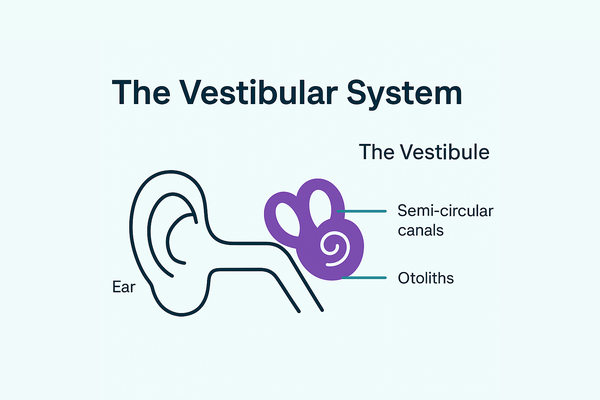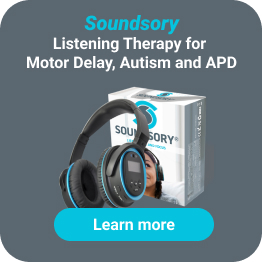Vestibular Input For Parents: What It Is, Why It Matters, and How to Help Your Child? (With Expert Tips)
 Rachel Ann Melegrito
Rachel Ann Melegrito Occupational Therapist
June 27, 2025
Have you ever closed your eyes on a road trip and still felt the car turning? That’s your brain using a hidden sense, the vestibular system, to track movement and balance.
Unlike other senses, the vestibular system works in the background, helping you stay steady, coordinate movement, and react to motion without even thinking about it. It’s one of the first senses to develop, working before birth to support balance and movement [1].
If your child is always spinning, swinging, and bouncing, or if they struggle with coordination and avoid movement, their vestibular system might need extra support.
As an occupational therapist, I’ve worked with children who seek constant motion and others who avoid movement activities. But structured movement programs and vestibular input activities can help – and Soundsory® is designed to support sensory development through sound and movement.
What Is Vestibular Input and Why Is It Important?
Vestibular input is the information your inner ear receives to help your brain understand how your head is moving and where it is in space.
Inside your inner ear, tiny hair cells in special structures (called the semicircular canals and otolith organs) detect different types of movement:
✅ Linear: Moving forward or backward (like riding a bike).
✅ Rotational: Spinning in circles (like twirling on a swing).
✅ Up and down: Jumping or bouncing.
When your head moves, these hair cells bend and send signals to your brain, helping you stay balanced and coordinated.
Erika Trump, MS, OTR/L, a pediatric occupational therapist at Spark Pediatric Therapy, explains: “The vestibular system is one of the most important sensory systems with connections to more parts of the brain than most other systems. It is responsible for and supports so many areas of life, including regulation, attention, muscle tone, eye movements, posture, coordination, balance, spatial processing, and overall orientation of ourselves in the world.”
This system works closely with other senses to support balance, coordination, and movement [2]:
- It’s important in posture and muscle tone, telling your brain to fire the right muscles to keep the body upright.
- It enables you to move and interact with the environment
- It works with vision to stabilize eye movements, allowing you to track objects or read.
- It affects attention, helping the brain stay alert and engaged.
- It works with the proprioceptive system to create smooth, controlled movements, allowing for better coordination and motor planning.
The vestibular system is like the body’s central organizer. It helps other senses, like vision, body awareness (proprioception) and touch, work together to keep you balanced and moving smoothly.
When the vestibular system isn’t working well, everyday activities can feel much harder. This might include:
- Struggling to walk steadily without tripping.
- Finding it difficult to sit upright for long periods.
- Having trouble focusing in school.
- Feeling uncoordinated during play and sports.
Because the vestibular system affects so many areas of life, supporting it through movement and sensory activities can make a big difference!

What Are the Signs That My Child Needs More Vestibular Input?
Every child processes movement differently. Some are overwhelmed by too much motion, while others can’t get enough. Think of it like having a different-sized cup for vestibular input: some children have small cups and need just a little to feel balanced, while others have big cups and need a lot more to stay regulated [3].
Signs of vestibular under-responsiveness (Sensory seeking)
Children who seek movement may:
🔹 Crave constant motion: spinning, jumping, or rocking.
🔹 Love intense activities: fast swings, trampolines, or rough play.
🔹 Struggle with balance and coordination, making bike riding and sports harder.
🔹 Have a high tolerance for spinning and rarely feel dizzy.
Signs of vestibular over-responsiveness (Gravitational insecurity)
Children who avoid movement may:
🔹 Fear swings, slides, or being lifted off the ground.
🔹 Feel anxious or dizzy in cars, on escalators, or on uneven surfaces.
🔹 Struggle with elevators or sudden motion changes.
Here are some examples of vestibular-seeking behaviors:
✅ Spinning in circles without getting dizzy.
✅ Running, jumping, or climbing nonstop.
✅ Rocking back and forth for long periods.
How Can I Support My Child With Vestibular Input in Daily Life? (Easy Activities for Home & School)
The first step in supporting your child is understanding their specific sensory needs. This may involve observing their behaviors and, if you haven’t already, seeking a formal assessment from an occupational therapist.
Most of the time, vestibular challenges are just one piece of the puzzle, but they tend to be more noticeable than other sensory difficulties.
Once you clearly understand your child’s needs, it becomes much easier to create a structured plan in collaboration with an OT.
A well-designed program with occupational therapy activities can help provide the right balance of vestibular input, ensuring that your child stays regulated throughout the day.
“The opportunity for vestibular inputs is critical for development. Opportunities for movement in daily life can make a big difference, from playing at the playground to being tossed in the air by mom to rolling down a hill outside,” says Erika Trump.
These activities can be seamlessly integrated into daily routines, whether it’s incorporating movement breaks during schoolwork or engaging in sensory-rich play before bedtime to help with relaxation.
As with any other sensory input, it’s better to keep them meaningful. That being said, try to provide vestibular input in the context of play or as part of their daily activities.
Erika Trump adds that parents should make the most of children’s natural drive to explore movement. “Parents can support their child by promoting physical movement over sedentary activities and allowing kids to explore more ‘risky’ movement activities, with appropriate supervision.”
Some indoor vestibular exercises you can try include:
- Yoga, particularly poses like sky earth stretches and downward dog
- Simple stretches and exercises like head turns and head lifts
- Play with front/back or side-side jumping and relays and circle spins
- Balance activities for kids
When it comes to outdoor vestibular activities, here are some ideas:
- Jumping on a trampoline
- Playing on a playground, like slides, seesaws, merry-go-round, and monkey bars.
For more tips and exercises videos, consult our free guide with the 10 best exercises for vestibular input.
What Are the Symptoms of Too Much Vestibular Input?
While vestibular activities are beneficial, too much input can overstimulate your child’s nervous system. Signs of overstimulation may include dizziness, nausea, difficulty focusing, irritability, and hyperactivity.
Problems with the vestibular system may also cause these symptoms, as well as the following [4]:
- Vertigo
- Visual disturbances
- Hearing changes
- Learning and memory problems
- Problems with navigation
To balance vestibular input, pair movement with proprioceptive input, such as deep pressure and heavy work activities.
Providing breaks between high-energy activities can also help. Soundsory® can be a useful tool for structured movement and auditory support to prevent overstimulation while still offering necessary sensory input.
Final Thoughts: Helping Your Child Thrive with Vestibular Input
The vestibular system is one of the least understood sensory systems, yet its challenges are often easy to spot. Recognizing vestibular difficulties and understanding how to provide appropriate input is essential in helping your child navigate daily life more easily.
Soundsory® offers an effective way to integrate movement and auditory stimulation, helping regulate the nervous system and improve motor skills.
If you’d like to explore more ways to support your child’s sensory needs, you can learn about different strategies in our related resources on vestibular exercises, sensory input, and proprioceptive activities.
Frequently Asked Questions About Vestibular Input
How to get more vestibular input?
Engage in movement activities for kids. This can include swinging, spinning, jumping, and balancing exercises. Equipment like trampolines, swings, and monkey bars can also help provide vestibular stimulation.
Can vestibular input be calming?
Yes, vestibular input can be calming! Slow, rhythmic movements, such as rocking, gentle swinging, or linear motion, can have a calming effect.
What is the difference between vestibular and proprioceptive input?
The key difference between vestibular and propioceptive input is where the input comes from and how it helps you move.
🔹 Vestibular input comes from the inner ear and helps you sense balance, movement, and head position relative to gravity. It tells your brain if you’re upright, upside down, or in motion.
🔹 Proprioceptive input comes from muscles, tendons, and joints and helps you understand where your body is in space without looking. It tells you how much force to use when picking up an object or how to position your limbs when walking.
Both systems work together to support coordination, movement, and body awareness. For example, when you jump, your vestibular system detects the motion, while your proprioceptive system helps you land smoothly.
Is jumping proprioceptive or vestibular?
Jumping is both propioceptive and vestibular! Most movements engage both systems: jumping moves your head in space (=vestibular) while activating muscles and joints (=proprioceptive).
References
1. Božanić Urbančič, N., Battelino, S., & Vozel, D. (2023). Appropriate Vestibular Stimulation in Children and Adolescents-A Prerequisite for Normal Cognitive, Motor Development and Bodily Homeostasis-A Review. Children (Basel, Switzerland), 11(1), 2. https://doi.org/10.3390/children11010002
2. Wiener-Vacher, S. R., Hamilton, D. A., & Wiener, S. I. (2013). Vestibular activity and cognitive development in children: perspectives. Frontiers in integrative neuroscience, 7, 92. https://doi.org/10.3389/fnint.2013.00092
3. Case-Smith, J., O’Brien, J. C. (Eds.), Occupational therapy for children, (6th Edition). Mosby Elsevier, Maryland Heights, MO
4. Casale J, Browne T, Murray IV, et al. Physiology, Vestibular System. [Updated 2023 May 1]. In: StatPearls [Internet]. Treasure Island (FL): StatPearls Publishing; 2025 Jan-. Available from: https://www.ncbi.nlm.nih.gov/books/NBK532978/



